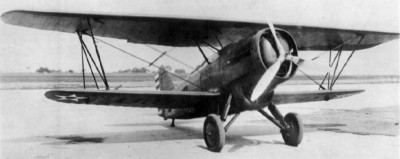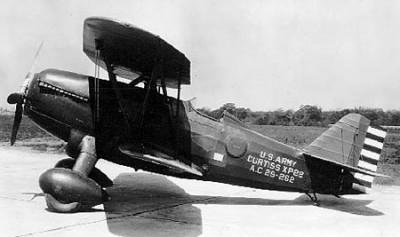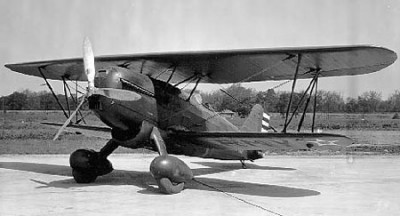| Název: Name: | Curtiss XP-22 | Curtiss XP-22 |
| Originální název: Original Name: | Curtiss XP-22 | |
| Kategorie: Category: | stíhací letoun | fighter aeroplane |
| Výrobce: Producer: | DD.MM.1931-DD.MM.1931 Curtiss-Wright Corp., Buffalo, New York | |
| Období výroby: Production Period: | DD.MM.1931-DD.MM.1931 | |
| Vyrobeno kusů: Number of Produced: | 1 | |
| První vzlet: Maiden Flight: | DD.06.1931 | |
| Osádka: Crew: | 1 | |
| Základní charakteristika: Basic Characteristics: | ||
| Vzlet a přistání: Take-off and Landing: | CTOL - konvenční vzlet a přistání | CTOL - conventional take-off and landing |
| Uspořádání křídla: Arrangement of Wing: | dvouplošník | biplane |
| Uspořádání letounu: Aircraft Concept: | klasické | conventional |
| Podvozek: Undercarriage: | pevný | fixed |
| Přistávací zařízení: Landing Gear: | kola | wheels |
| Technické údaje: Technical Data: | ||
| Hmotnost prázdného letounu: Empty Weight: | 1178 kg | 2597 lb |
| Vzletová hmotnost: Take-off Weight: | 1521 kg | 3354 lb |
| Maximální vzletová hmotnost: Maximum Take-off Weight: | ? kg | ? lb |
| Rozpětí: Wingspan: | 9.6 m | 31ft 6in |
| Délka: Length: | 7.19 m | 23ft 7in |
| Výška: Height: | 2.67 m | 8ft 9in |
| Plocha křídla: Wing Area: | 23.41 m2 | 252 ft2 |
| Plošné zatížení: Wing Loading: | ? kg/m2 | ? lb/ft2 |
| Pohon: Propulsion: | ||
| Kategorie: Category: | pístový | piston |
| Počet motorů: Number of Engines: | 1 | |
| Typ: Type: | Curtiss V-1570-23 o výkonu 522 kW třílistá kovová vrtule | Curtiss V-1570-23, power 700 hp three-blade metal propeller |
| Objem palivových nádrží: Fuel Tank Capacity: | 189 l | 50 US gal |
| Výkony: Performance: | ||
| Maximální rychlost: Maximum Speed: | 325.7 km/h v 0 m | 202.4 mph in 0 ft |
| Cestovní rychlost: Cruise Speed: | 276.8 km/h v ? m | 172 mph in ? ft |
| Rychlost stoupání: Climb Rate: | 12.2 m/s | 2400 ft/min |
| Čas výstupu na výšku: Time to Climb to: | 5.2 min do 3048 m | 5.2 min to 10000 ft |
| Operační dostup: Service Ceiling: | 8077 m | 26500 ft |
| Dolet: Range: | ? km | ? mi |
| Maximální dolet: Maximum Range: | ? km | ? mi |
| Výzbroj: Armament: | 2x 7,62mm kulomet Browning | 2x .30 Browning machine gun |
| Uživatelské státy: User States: | | |
| Poznámka: Note: | - | - |
| Zdroje: Sources: | Bowers, P. M. Curtiss Aircraft 1907-1947, Putnam Aeronautical Books, London 1979. ISBN 0-370-10029-8. Bowers, P. M. Curtiss Army Hawks, Aircraft in Profile No.45. Profile Publications, Leatherhead 1965. United States Army and Air Force Fighters 1916-1961, Harleyford Publications, Letchworth 1961. Fahey, James C. U.S. Army Aircraft 1908-1946. Ships and Aircraft, Falls Church, 1964. Bowers, P. M. Forgotten Fighters/2 and Experimental Aircraft U.S. Army 1918-1941, Arco Publishing Company, New York 1971. ISBN 0-66802-403-8. http://joebaugher.com/usaf_fighters/p22.html www.nationalmuseum.af.mil | |
| Period | - |
| Producer | Curtiss |
| Type | Curtiss XP-22 Hawk |
| Camouflage | Prototypová |
 Olivově zelená / Olive Green Olivově zelená / Olive Green Žlutá / Yellow Žlutá / Yellow |
|
| Country |  |
| Pilot | - |
| Production No. | - |
| Serial No. / Evidence No. | 29-262 |
| Tactical Marking / Imatriculation | - |
| Name | - |
| Unit | - |
| Base | - |
| Date (DD.MM.RRRR) | DD.MM.RRRR |
| Author | - |
| Print size / 300 DPI | - |
| Published with authors permit | - |
| Author Website | - |
První podoba, s chladičem oleje v prstenci na přídi a původním podvozkem. Později se do zvětšeného prstence přesunul i hlavní chladič a podvozek byl nahrazen novým.


